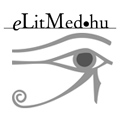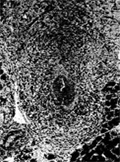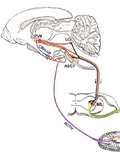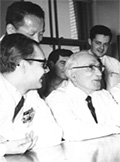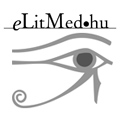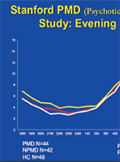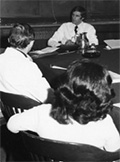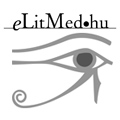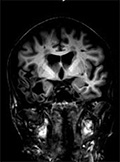The eLitMed.hu medical portal uses computer cookies for convenient operation. Detailed information can be found in the Cookie-policy.
Clinical Neuroscience - 2014;67(03-04)
Content
[HANS SELYE 70 YEARS LATER: STEROIDS, STRESS ULCERS & H. PYLORI]
[Although Hans Selye is mostly known for his discovery & development of the stress concept, he also introduced the first physiologically sound, structure-activity classification of steroids that was also based on the chemical structure of steroids in 1943. He not only introduced the names of glucocorticoids & mineralocorticoids but discovered the anti- & pro-inflammatory properties, respectively, of these steroids in animal models. Furthermore, he not only described the first stress-induced gastric ulcers in rats (1936) & characterized the first human ‘stress ulcers’ during the air-raids in London during World War II (1943). Thus, Selye was a much more productive & creative scientist than it is generally considered.]
[CATECHOLAMINES AND STRESS]
[A brief survey is offering of debates on two long-standing questions in stress studies and theories: 1) question of stress nonspecificity (i.e. homo- or heterogeneity in stress responses), and 2) what is the functional role of central catecholamines in stress mechanisms, especially in stress signaltransduction and in the realization of stress responses.]
[HANS SELYE AND THE STRESS RESPONSE: FROM “THE FIRST MEDIATOR” TO THE IDENTIFICATION OF THE HYPOTHALAMIC CORTICOTROPIN-RELEASING FACTOR]
[Selye pioneered the stress concept that is ingrained in the vocabulary of daily life. This was originally build on experimental observations that divers noxious agents can trigger a similar triad of endocrine (adrenal enlargement), immune (involution of thymus) and gut (gastric erosion formation) responses as reported in a letter to Nature in 1936. Subsequently, he articulated the underlying mechanisms and hypothesized the existence of a “first mediator” in the hypothalamus able to orchestrate this bodily changes. However he took two generations to identify this mediator. The Nobel Laureate, Roger Guillemin, a former Selye’s PhD student, demonstrated in 1955 the existence of a hypothalamic factor that elicited adrenocorticotropic hormone release from the rat pituitary and named it corticotropin releasing factor (CRF). In 1981, Wylie Vale, a former Guillemin’s Ph Student, characterized CRF as 41 amino acid and cloned the CRF1 and CRF2 receptors. This paves the way to experimental studies establishing that the activation of the CRF signaling pathways in the brain plays a key role in mediating the stress-related endocrine, behavioral, autonomic and visceral responses. The unraveling of the biochemical coding of stress is rooted in Selye legacy continues to have increasing impact on the scientific community.]
[THE SURPRISING DUAL ACTION OF GLUCOCORTICOIDS]
[Glucocorticoid hormones may have dual action on the stomach: physiological gastroprotective and pathological proulcerogenic one. In physiological conditions, even in acute stress situations, glucocorticoids have an adaptive effect on the stomach and, therefore, are gastroprotective. The findings that we review in this article suggest that glucocorticoids released during acute stress are naturally occurring protective factors that play an important role in maintenance of the gastric mucosal integrity.]
[SELYE’S CONCEPT OF PLURICAUSAL DISEASES AND ITS IMPACT ON REGULATORY SCIENCE]
[Science assumed in recent decades an increasingly important role in the regulatory field. Regulatory science is now regarded as established specific brunch of science. A disturbing anomaly, the emergence of fraudulent data is of major concern both in the field of research and in the regulation. Hans Selye’s work on stress, on several forms of pluricausal diseases and on other experimental models came into the focus of interest on the occasion of the Selye Symposium - 2013 held in May 2013 at the Hungarian Academy of Sciences in Budapest.]
[STRESS IN THE CLASSIFICATION OF PITUITARY TUMORS. FOCUS ON AGGRESSIVE PITUITARY ADENOMAS]
[After a brief summary of the stress concept and the contribution of Dr. Hans Selye, this publication focuses on the classification of pituitary neoplasms and the difficulties to provide conclusive information on the prognosis of various pituitary tumor types. The term “aggressive pituitary tumors” was introduced. These tumors have a rapid cell proliferation rate. At present, the assessment of Ki-67 nuclear labeling index appears to be the simplest and most reliable method to evaluate tumor cell multiplication. Further studies on pituitary tumor biomarkers are needed.]
[CENTRAL NEUROENDOCRINE MECHANISMS OF GASTROPROTECTION]
[Selye recognized the importance of activation of hypothalamic- pituitary-adrenal axis during stress and the connection between central nervous system and neuroendocrine regulation. This concept basically contributed to initiation of the studies, which revealed the importance of brain gut axis in regulation of gastric mucosal integrity. Several neuropeptides, such as thyreotrop releasing hormones, adrenomedullin, peptide YY, amylin, opioid peptides, nociceptin, nocisatin, substance P, ghrelin, leptin, orexin-A, angiotensin II were shown to induce gastroprotective effect injected centrally. Though the involvement of dorsal vagal complex and vagal nerves in conveying the central action to the periphery has been well documented, additional mechanisms have also been raised. The interaction between neuropeptides further component that may modify the gastric mucosal resistance to noxious stimulus.]
[EVEN VISITING SCIENTISTS COULD MAKE DISCOVERIES IN MONTREAL]
[This publication summarizes the scientific adventure with Professor Selye, and focuses on the specific effect of rare metal salts on reticuloendothelial functions. Rare earth metal ions markedly affect the functions of cells involved in inflammatory and immunological phenomena. The Kupffer cell blockade induced by GdCl3 is a generally accepted method for investigation of the physiological and pathophysiological roles of Kupffer cells. Potential beneficial effects of macrophage blockade have been demonstrated in different shock states, liver injury and obstructive jaundice.]
[A PSYCHIATRIST’S PERSPECTIVES ON STRESS, STEROIDS AND MENTAL ILLNESS]
[The relationship between stress and mental illness has been extensively studied and there is a growing consensus that the occurrence of mental illness rather depends on a combination of factors than is caused by stressful external events. Significant hypothalamus pituitary adrenal axis abnormalities were observed among others in major depressive disorder and bipolar disorder. In both disorders, the extent of change in cortisol level was related to the severity of illness and to cognitive changes. Exogenous use of synthetic steroids also frequently resulted in severe psychiatric symptoms. In conclusion changes in the level of steroid hormones may cause impairments in the brain.]
[HANS SELYE: AN INSPIRING TEACHER]
[The souvenirs of Hans Selye as a teacher of graduate and post graduate students are presented and discussed. The main aim of his teaching was to orient the student toward importance and originality of findings.]
[PERSONAL RECOLLECTIONS OF DR. HANS SELYE AND OF HIS INSTITUT DE MÈDECINE ET DE CHIRURGIE EXPÈRIMENTALES (IMCE)]
[This article is a short personal recollection of Dr. Hans Selye (HS) and of his institute in order to show, first, why and how he influenced us; second, who he was as a person, human being, physician, scientist, professor, mentor; third, what was the structure and functioning of the Institut de mèdecine et chirurgie expèrimentales (IMCE) and fourth, what HS’ contributions and accomplishments were.]
[Validation of the Hungarian MDS-UPDRS: Why do we need a new Parkinson scale?]
[Background - The Movement Disorder Society-sponsored revision of the Unified Parkinson’s Disease Rating Scale (MDS-UPDRS) has been published in 2008 as the successor of the original UPDRS. The MDS-UPDRS organizing team developed guidelines for the development of official non- English translations consisting of four steps: translation/back-translation, cognitive pretesting, large field testing, and clinimetric analysis. The aim of this paper was to introduce the new MDS-UPDRS and its validation process into Hungarian. Methods - Two independent groups of neurologists translated the text of the MDS-UPDRS into Hungarian and subsequently back-translated into English. After the review of the back-translated English version by the MDS-UPDRS translation administration team, cognitive pretesting was conducted with ten patients. Based on the results of the initial cognitive pretesting, another round was conducted. For the large field testing phase, the Hungarian official working draft version of MDS-UPDRS was tested with 357 patients with Parkinson’s disease (PD). Confirmatory factor analyses (CFA) determined whether the factor structure for the English-language MDS-UPDRS could be confirmed in data collected using the Hungarian Official Draft Version. To become an official translation, the Comparative Fit Index (CFI) had to be ≥0.90 compared to the English-language version. Results - For all four parts of the Hungarian MDS-UPDRS, the CFI was ≥0.94. Conclusion - The overall factor structure of the Hungarian version was consistent with that of the English version based on the high CFIs for all the four parts of the MDSUPDRS in the CFA; therefore, this version was designated as the ‘OFFICIAL HUNGARIAN VERSION OF THE MDSUPDRS.’]
[Association of temporal lobe inflammatory leukoencephalopathy with two B cell malignancies]
[Identification of etiological connections among virtually distinct diseases in a patient may be sometimes challenging. We report a unique case with two B cell malignancies and an inflammatory leukoencephalopathy. Three days prior to admission, the elderly male patient developed fatigue, headaches, recurrent vomiting, memory disturbances, depression and somnolence. Clinical, laboratory and imaging evaluations as well as post mortem histological studies were performed. Simultaneous presence of primary central nervous system B cell lymphoma, temporal lobe inflammatory leukoencephalopathy and multiple (smoldering) myeloma, was revealed by the detailed work up in the treatmentnaïve patient. Based on recent data from genomic studies, we propose that a sequential evolution of molecular pathology lead to the co-occurrence of multiple myeloma and primary central nervous system B cell lymphoma in this patient, and interpret the development of the temporal lobe leukoencephalopathy as a likely paraneoplastic complication of smoldering myeloma.]
[Dilemma of further therapeutic step in RRMS in case of ineffectivity of first line treatment: fingolimod or natalizumab?]
[Dilemma of further therapeutic step in RRMS in case of ineffectivity of first line treatment: fingolimod or natalizumab? 2014;67(03-04)]
1.
Clinical Neuroscience
[Headache registry in Szeged: Experiences regarding to migraine patients]2.
Clinical Neuroscience
[The new target population of stroke awareness campaign: Kindergarten students ]3.
Clinical Neuroscience
Is there any difference in mortality rates of atrial fibrillation detected before or after ischemic stroke?4.
Clinical Neuroscience
Factors influencing the level of stigma in Parkinson’s disease in western Turkey5.
Clinical Neuroscience
[The effects of demographic and clinical factors on the severity of poststroke aphasia]1.
2.
Clinical Oncology
[Pancreatic cancer: ESMO Clinical Practice Guideline for diagnosis, treatment and follow-up]3.
Clinical Oncology
[Pharmacovigilance landscape – Lessons from the past and opportunities for future]4.
5.





